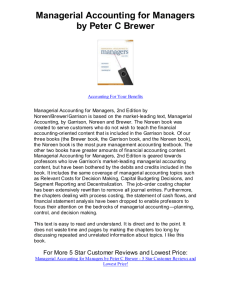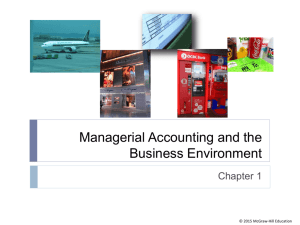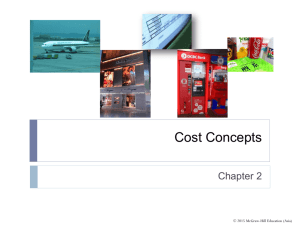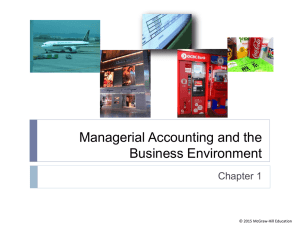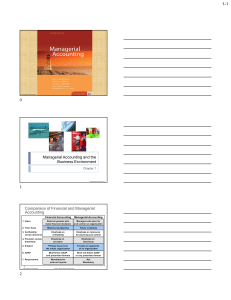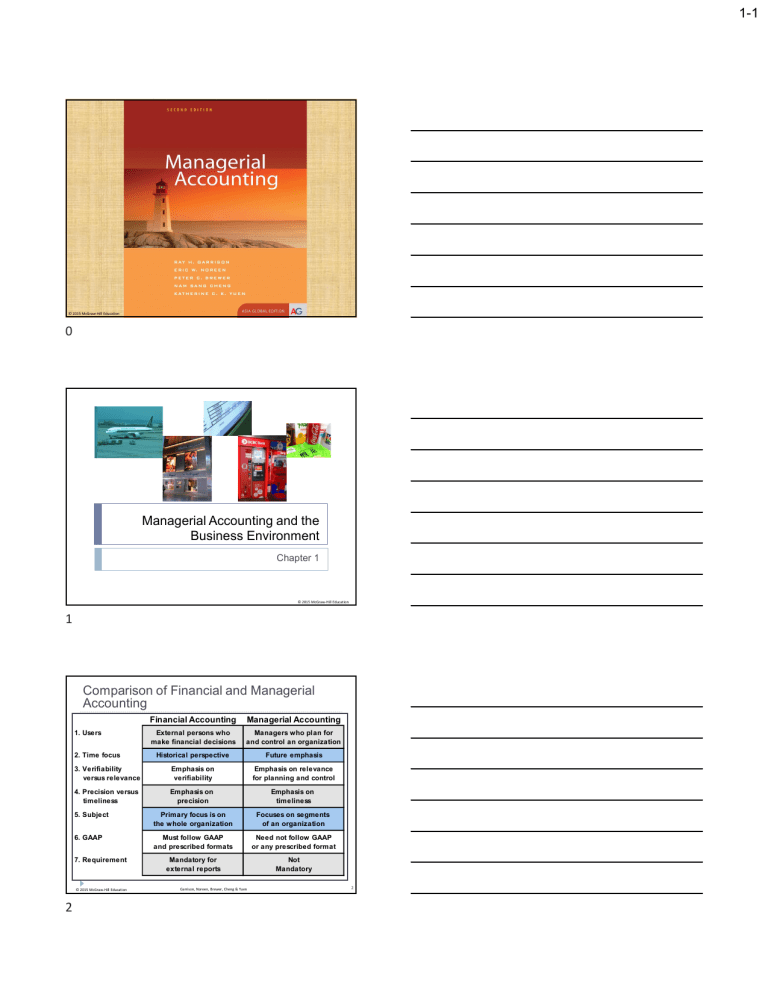
1-1 © 2015 McGraw-Hill Education Garrison, Noreen, Brewer, Cheng & Yuen 0 Managerial Accounting and the Business Environment Chapter 1 © 2015 McGraw-Hill Education 1 Comparison of Financial and Managerial Accounting 1. Users 2. Time focus Managerial Accounting External persons who make financial decisions Managers who plan for and control an organization Historical perspective Future emphasis 3. Verifiability versus relevance Emphasis on verifiability Emphasis on relevance for planning and control 4. Precision versus timeliness Emphasis on precision Emphasis on timeliness 5. Subject Primary focus is on the whole organization Focuses on segments of an organization 6. GAAP Must follow GAAP and prescribed formats Need not follow GAAP or any prescribed format Mandatory for external reports Not Mandatory 7. Requirement © 2015 McGraw-Hill Education 2 Financial Accounting Garrison, Noreen, Brewer, Cheng & Yuen 2 1-2 Work of Management Planning Controlling Decision Making 3 Garrison, Noreen, Brewer, Cheng & Yuen © 2015 McGraw-Hill Education 3 Planning Establish Goals. Specify How Goals Will Be Achieved. Develop Budgets. © 2015 McGraw-Hill Education Garrison, Noreen, Brewer, Cheng & Yuen 4 4 Controlling The control function gathers feedback to ensure that plans are being followed. Feedback in the form of performance reports that compare actual results with the budget are an essential part of the control function. © 2015 McGraw-Hill Education 5 Garrison, Noreen, Brewer, Cheng & Yuen 5 1-3 Decision Making Decision making involves making a selection among competing alternatives. What should we be selling? Who should we be serving? How should we execute? © 2015 McGraw-Hill Education Garrison, Noreen, Brewer, Cheng & Yuen 6 6 Management Accounting and Cost Accounting Management Accounting relates to the provision of appropriate information, including cost information for decision-making, planning, control, and performance evaluation. Cost accounting defines costs and valuates inventories to help managers to run businesses; examples including FIFO, weighted average inventory valuation technique Job costing, Process costing, Activity-based costing Cost allocation techniques Management Accounting and Cost Accounting • are intertwined and • the terms are sometimes interchangeable their functions are to help companies make better decisions © 2015 McGraw-Hill Education Garrison, Noreen, Brewer, Cheng & Yuen 7 7 Managerial Accounting and Globalization © 2015 McGraw-Hill Education 8 Garrison, Noreen, Brewer, Cheng & Yuen 8 1-4 World Merchandise Exports 60.0 Percentage of World Merchandise Exports by Region 50.0 40.0 30.0 20.0 10.0 0.0 1948 1953 1963 1973 1983 1993 2003 North America South and Central America Europe Commonwealth of Independent States (CIS) Africa Middle East 2012 Asia Source: World Trade Organization Statistic 2013 © 2015 McGraw-Hill Education Garrison, Noreen, Brewer, Cheng & Yuen 9 9 Internet Penetration Rate And Borderless Trading Potential The Internet fuels globalization by providing companies with greater access to geographically dispersed customers, employees, and suppliers. As of June 2012, more than 66% of the world's population was still not connected to the Internet. © 2015 McGraw-Hill Education Garrison, Noreen, Brewer, Cheng & Yuen 10 10 A Strategic View of Managerial Accounting A strategy is a “game plan” that enables a company to attract customers by distinguishing itself from competitors. The focal point of a company’s strategy should be its target customers. © 2015 McGraw-Hill Education 11 Garrison, Noreen, Brewer, Cheng & Yuen 11 1-5 Customer Value Propositions Customer Intimacy Strategy Understand and respond to individual customer needs. Operational Excellence Strategy Deliver products and services faster, more conveniently, and at lower prices. Product Leadership Strategy Offer higher quality products. © 2015 McGraw-Hill Education Garrison, Noreen, Brewer, Cheng & Yuen 12 12 Value Creation: Value-added activities and processes Create value to stakeholders Need to pay attention to value-added (vs. non-valueadded) activities and processes Possible techniques focusing on value-added activities and processes include: Activity-based costing and management Lean production Just-in-time inventory management and production Theory of Constraints Kaizen costing Life-cycle costing Target pricing and costing Quality management, e.g. total quality management and six sigma © 2015 McGraw-Hill Education Garrison, Noreen, Brewer, Cheng & Yuen 13 13 Value Creation: Different Perspectives External Perspectives – Value chain management Internal Perspectives – Value chain management Suppliers (upstream) Customers (downstream) Business processes (examples mentioned in slide 17) Leadership Perspective Leaders who can unite behaviors of fellow employees Need to consider intrinsic and extrinsic motivating factors Need to be aware of cognitive biases that adversely affect planning, controlling and decision making. Cultural Perspective National and organizational cultures Power distance, individualism, uncertainty avoidance, masculinity and long-term orientation © 2015 McGraw-Hill Education 14 Garrison, Noreen, Brewer, Cheng & Yuen 14 1-6 Process Management A business process is a series of steps that are followed in order to carry out some task in a business. R&D Product Design Customer Manufacturing Marketing Distribution Service Business functions making up the value chain © 2015 McGraw-Hill Education Garrison, Noreen, Brewer, Cheng & Yuen 15 15 Managerial Accounting: Beyond the Numbers In addition to the External, Internal, Leadership and Cultural Perspectives, the following four business management perspectives also go beyond the numbers to enable intelligent planning, control, and decision making: • An Ethics Perspective • A Corporate Governance Perspective • An Enterprise Risk Management Perspective • A Corporate Social Responsibility and Sustainability Perspective © 2015 McGraw-Hill Education Garrison, Noreen, Brewer, Cheng & Yuen 16 16 An Ethics Perspective All Professional Management Accountants Bodies issue their own Code of Conduct but they all share similar fundamental principles and conceptual approaches as the one issued by the Institute of Management Accountants. The Institute of Management Accountants’ (IMA) Statement of Ethical Professional Practice consists of two parts that offer guidelines for: Ethical behavior. Resolution for an ethical conflict. © 2015 McGraw-Hill Education 17 Garrison, Noreen, Brewer, Cheng & Yuen 17 1-7 An Ethics Perspective: IMA Guidelines for Ethical Behavior Recognize and communicate professional limitations that preclude responsible judgment. Maintain professional competence. Competence Follow applicable laws, regulations and standards. Provide accurate, clear, concise, and timely decision support information. © 2015 McGraw-Hill Education Garrison, Noreen, Brewer, Cheng & Yuen 18 18 An Ethics Perspective: IMA Guidelines for Ethical Behavior Do not disclose confidential information unless legally obligated to do so. Do not use confidential information for unethical or illegal advantage. Confidentiality Ensure that subordinates do not disclose confidential information. © 2015 McGraw-Hill Education Garrison, Noreen, Brewer, Cheng & Yuen 19 19 An Ethics Perspective: IMA Guidelines for Ethical Behavior Mitigate conflicts of interest and advise others of potential conflicts. Refrain from conduct that would prejudice carrying out duties ethically. Integrity Abstain from activities that might discredit the profession. © 2015 McGraw-Hill Education 20 Garrison, Noreen, Brewer, Cheng & Yuen 20 1-8 An Ethics Perspective: IMA Guidelines for Ethical Behavior Communicate information fairly and objectively. Credibility Disclose delays or deficiencies in information timeliness, processing, or internal controls. Disclose all relevant information that could influence a user’s understanding of reports and recommendations. © 2015 McGraw-Hill Education Garrison, Noreen, Brewer, Cheng & Yuen 21 21 An Ethics Perspective: IMA Guidelines for Resolution of an Ethical Conflict Follow employer’s established policies. For an unresolved ethical conflict: Discuss the conflict with immediate supervisor or next highest uninvolved manager. If immediate supervisor is the CEO, consider the board of directors or the audit committee. Contact with levels above the immediate supervisor should only be initiated with the supervisor’s knowledge, assuming the supervisor is not involved. © 2015 McGraw-Hill Education Garrison, Noreen, Brewer, Cheng & Yuen 22 22 An Ethics Perspective: IMA Guidelines for Resolution of an Ethical Conflict Follow employer’s established policies. For an unresolved ethical conflict: Except where legally prescribed, maintain confidentiality. Clarify issues in a confidential discussion with an objective advisor. Consult an attorney as to legal obligations. © 2015 McGraw-Hill Education 23 Garrison, Noreen, Brewer, Cheng & Yuen 23 1-9 An Ethics Perspective: Why Have Ethical Standards? Ethical standards in business are essential for a smooth functioning economy. Without ethical standards in business, the economy, and all of us who depend on it for jobs, goods, and services, would suffer. Abandoning ethical standards in business would lead to a lower quality of life with less desirable goods and services at higher prices. © 2015 McGraw-Hill Education 24 Garrison, Noreen, Brewer, Cheng & Yuen 24 An Ethics Perspective: Company Codes of Conduct Broad-based statements of a company’s responsibilities to: Employees Customers Suppliers And to the communities in which the company operates. © 2015 McGraw-Hill Education Garrison, Noreen, Brewer, Cheng & Yuen 25 25 An Ethics Perspective: Codes of Conduct on the International Level The Code of Ethics for Professional Accountants, issued by the International Federation of Accountants (IFAC), governs the activities of professional accountants worldwide. In addition to integrity and objectivity, resolution of ethical conflicts, competence, and confidentiality, the IFAC’s code deals with the accountant’s ethical responsibilities in: Taxes, Independence, Fees and commissions, Advertising and solicitation, Handling of monies, and Cross-border activities. © 2015 McGraw-Hill Education 26 Garrison, Noreen, Brewer, Cheng & Yuen 26 1-10 A Corporate Governance Perspective The system by which a company is directed and controlled. Board of Directors Incentives and monitoring for Top Management To pursue objectives of Stockholders © 2015 McGraw-Hill Education Garrison, Noreen, Brewer, Cheng & Yuen 27 27 A Corporate Governance Perspective: The Sarbanes-Oxley Act of 2002 The Sarbanes-Oxley Act of 2002 was intended to protect the interests of those who invest in publicly traded companies by improving the reliability and accuracy of corporate financial reports and disclosures. Six key aspects of the legislation include: The Act requires both the CEO and CFO to certify in writing that their company’s financial statements and disclosures fairly represent the results of operations. The Act establishes the Public Company Accounting Oversight Board to provide additional oversight of the audit profession. The Act places the power to hire, compensate, and terminate public accounting firms in the hands of the audit committee. The Act places restrictions on audit firms, such as prohibiting public accounting firms from providing a variety of non-audit services to an audit client. © 2015 McGraw-Hill Education Garrison, Noreen, Brewer, Cheng & Yuen 28 28 A Corporate Governance Perspective: The Sarbanes-Oxley Act of 2002 (continued) The Act requires a public company’s independent auditor to issue an opinion on the effectiveness of the company’s internal control over financial reporting to accompany management’s assessment, and both are included in the company’s annual report. The Act establishes severe penalties for certain behaviors, such as: • Up to 20 years in prison for altering or destroying any documents that may eventually be used in an official proceeding. • Up to 10 years in prison for retaliating against a “whistle blower.” © 2015 McGraw-Hill Education 29 Garrison, Noreen, Brewer, Cheng & Yuen 29 1-11 An Enterprise Risk Management Perspective Should I try to avoid the risk, share the risk, accept the risk, or reduce the risk? A process used by a company to proactively identify and manage risk. Once a company identifies its risks, perhaps the most common risk management tactic is to reduce risks by implementing specific controls. 30 Garrison, Noreen, Brewer, Cheng & Yuen © 2015 McGraw-Hill Education 30 An Enterprise Risk Management Perspective Examples of Business Risks ● Products harming customers ● Losing market share due to the unforeseen actions of competitors ● Poor weather conditions shutting down operations ● Website malfunction ● A supplier strike halting the flow of raw materials ● Financial statements unfairly reporting the value of inventory ● An employee accessing unauthorized information Examples of Controls to Reduce Business Risks ● Develop a formal and rigorous new product testing program ● Develop an approach for legally gathering information about competitors' plans and practices ● Develop contingency plans for overcoming weather-related disruptions ● Thoroughly test the website before going "live" on the Internet ● Establish a relationship with two companies capable of providing raw materials ● Count the physical inventory on hand to make sure that it agrees with the accounting records ● Create password-protected barriers that prohibit employees from obtaining information not needed to do their jobs 31 Garrison, Noreen, Brewer, Cheng & Yuen © 2015 McGraw-Hill Education 31 Corporate Social Responsibility & Sustainability Perspective Corporate social responsibility (CSR) is a concept whereby organizations consider the needs of all stakeholders when making decisions. Customers Employees Suppliers Communities Stockholders Environmental & Human Rights Advocates CSR extends beyond legal compliance to include voluntary actions that satisfy stakeholder expectations. © 2015 McGraw-Hill Education 32 Garrison, Noreen, Brewer, Cheng & Yuen 32 1-12 Corporate Social Responsibility & Sustainability Perspective Examples of Corporate Social Responsibility Companies should provide customers with: Companies and their suppliers should provide ● Safe, high quality products that are fairly employees with: priced ● Safe and humane working conditions ● Competent, courteous, and rapid delivery ● Non-discriminatory treatments and the of products and services right to organize and file grievances ● Full disclosure of product-related risks ● Fair compensation ● Easy to use information systems for ● Opportunities for training, promotion, shopping and tracking orders and personal development Companies should provide suppliers with: Companies should provide communities with: ● Fair contract terms and prompt payments ● Payment of fair taxes ● Reasonable time to prepare orders ● Honest information about plans such as ● Hassle-free acceptance of timely and plant closings complete deliveries ● Resources that support charities, schools, ● Cooperative rather than unilateral and civic activities actions ● Reasonable access to media sources Companies should provide stockholders with: Companies should provide environmental ● Competent management and human rights advocates with: ● Easy access to complete and accurate ● Greenhouse gas emissions data financial information ● Recycling and resource conservation data ● Full disclosure of enterprise risks ● Child labor transparency ● Honest answers to knowledgeable ● Full disclosure of suppliers located in questions developing countries © 2015 McGraw-Hill Education Garrison, Noreen, Brewer, Cheng & Yuen 33 33 Corporate Social Responsibility & Sustainability Perspective Sustainability Global Reporting Initiative (GRI) • promotes a systematic and standardized approach o to corporate social responsibility and embed it in corporate culture; o to stimulate demand for sustainability information; thus benefitting both reporting organizations and report users. International Federation of Accountants (IFAC) Sustainability Framework • Organizations should o achieve a “Triple Bottom-Line” Economic, environmental an social goals (or 3Ps: Profit, Planet, and People) promote a sound corporate governance and ethical responsibility to ensure financial success through ethical operations and transactions; promote cultural diversity and equality; provide opportunities for social and economic development of the communities; and minimize environmental damages, and provide a safe working and living environment for the communities. © 2015 McGraw-Hill Education Garrison, Noreen, Brewer, Cheng & Yuen 34 34 Sustainability Reporting: GRI Registered Companies Examples of GRI Registered Companies Asia: Air China, AsusTek, Canon, Reliance Industries, Samsung Securities, SingTel Europe: Air France-KLM, BP, Daimler, Nestle, Nokia United States: AT&T, Dell, ExxonMobil, Intel, Johnson & Johnson © 2015 McGraw-Hill Education 35 Garrison, Noreen, Brewer, Cheng & Yuen 35 1-13 Professional Qualification of Management Accountants • Traditional accounting qualifications, e.g. Chartered Accountants (ACA), Certified Public Accountants (CPA) and Chartered Certified Accountants (ACCA) • Management accountants qualifications, e.g.: Institution Abbrev Country Qualification The Institute of Management Accountants IMA US CMA Certified Management Accountants of Canada CMA Canada Canada CMA (previously known as The Society of Management Accountants of Canada) The Chartered Institute of Management Accountants CIMA UK FCMA , ACMA The Institute of Certified Management Accountants of Australia ICMA Australia CMA - CMA Philippines Philippines CMA - CMA Indonesia Indonesia CMA Sri Lanka CMA © 2015 McGraw-Hill Education 36 Garrison, Noreen, Brewer, Cheng & Yuen - CMA Sri Lanka 36 End of Chapter 1 © 2015 McGraw-Hill Education 37 Garrison, Noreen, Brewer, Cheng & Yuen 37
